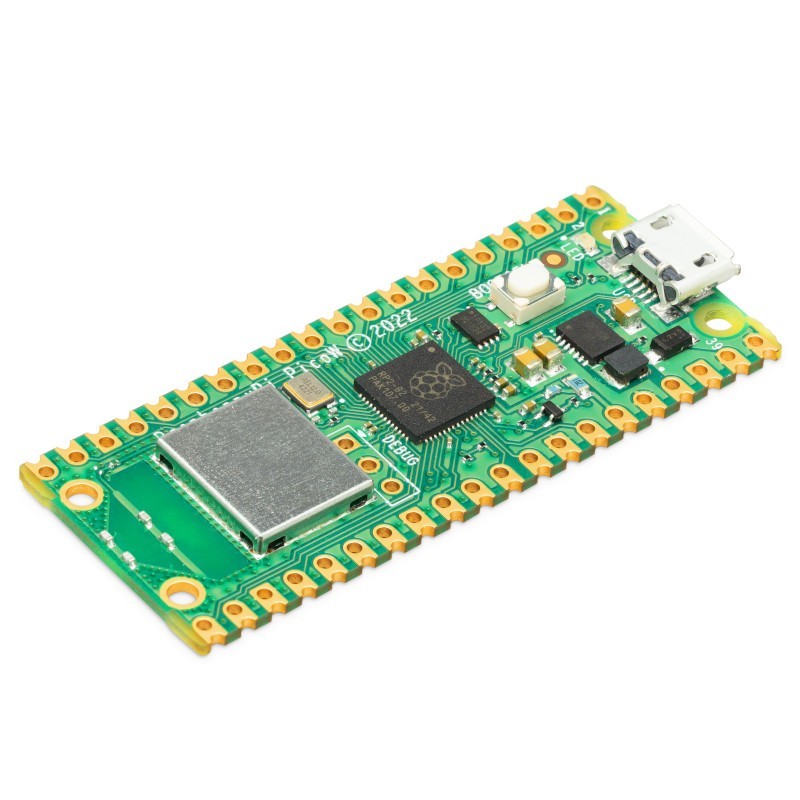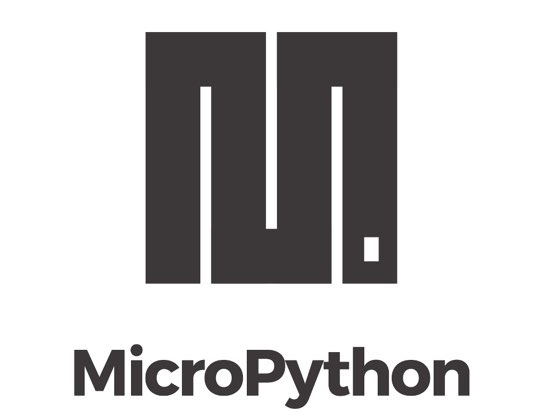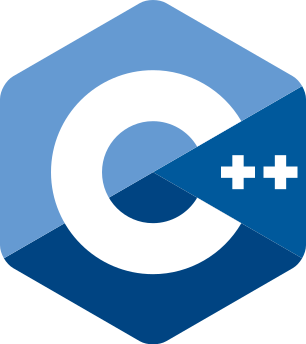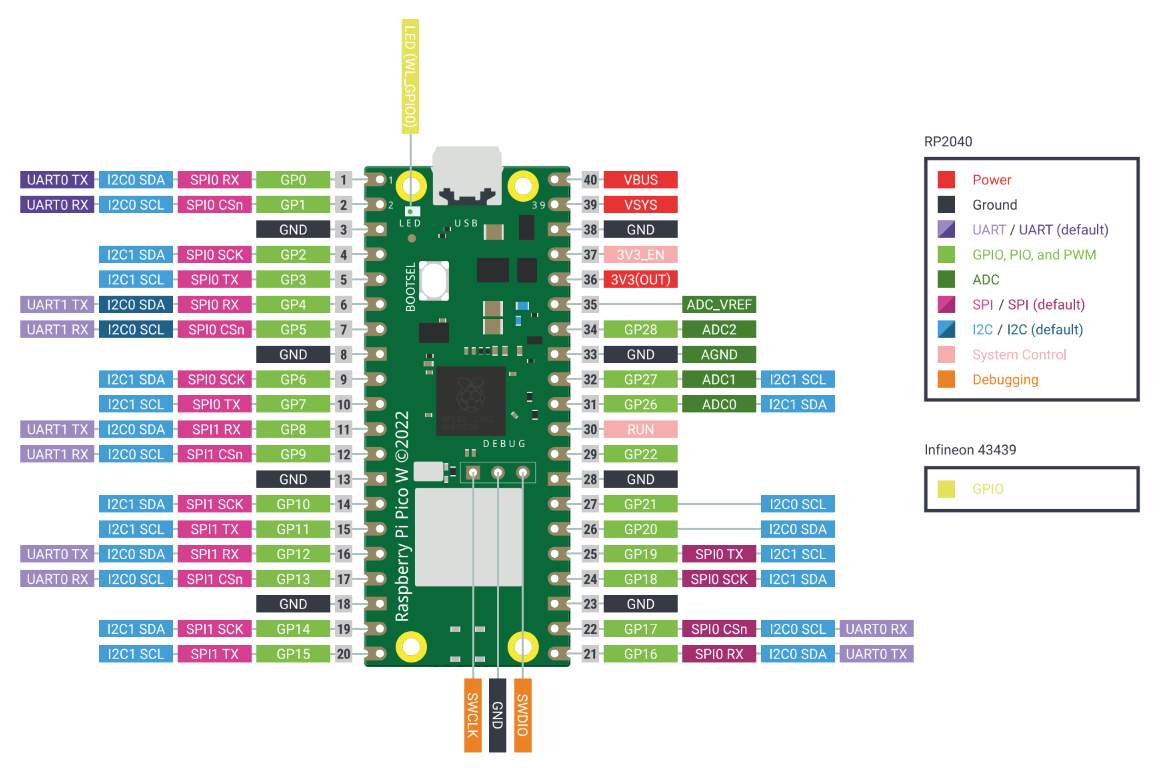




zł23.50 tax excl.
The board with the RP2040 microcontroller equipped with two ARM Cortex-M0 + cores operating at a frequency of 133 MHz, 264 kB RAM. The board also has 2 MB of QSPI flash memory. In addition, the board is equipped with the Infineon CYW43439 system, extending the board with wireless connectivity. Raspberry Pi SC0918
The Raspberry Pi Pico is the first board to feature a microcontroller designed by the Raspberry Pi foundation. The chip that is the heart of this board has been equipped with two ARM Cortex M0+ cores operating at a frequency of 133 MHz, 256 KB of RAM and 30 GPIO ports. The microcontroller itself is not equipped with flash memory, but on the board there is an external memory with a capacity of 2 MB connected via the QSPI interface. In addition, the board is equipped with the Infineon CYW43439 system, extending the board with wireless connectivity. The module provides WiFi connectivity in the IEEE 802.11 b / g / n standard. The platform supports the popular MicroPython and C/C++ programming languages. Programs can be uploaded to memory via the USB interface in mass storage mode or by using an external programmer that supports the SWD interface.

Kamami is the official distributor of Raspberry Pi minicomputers and dedicated accessories.

MicroPython is a special version of the Python 3 programming language, prepared to run directly on embedded systems such as the Raspberry Pi Pico. The version prepared especially for the RP2040 microcontroller, supports REPL, an interactive shell that allows you to execute scripts, typing into the console and viewing the results of the program in it. Thanks to this technology, it is also possible to save the program in flash memory.
To facilitate the programming of the RP2040 microcontroller in C / C ++, the Raspberry Pi Foundation has prepared an official SDK toolkit that can be integrated with popular IDEs such as Visual Studio Code or Eclipse. The entire environment configuration process is described in the Getting started with Raspberry Pi Pico document.


The Raspberry Pi Pico can be programmed via the USB interface, it can be done in two ways.
The first is the USB mass storage mode, to program the board in this way, press and hold the BOOTSEL button, and then connect the board to the computer with a USB cable. The device will be recognized as mass memory to which you can upload the program in the same way as copying files to a pendrive. After uploading the program, the microcontroller will automatically reset and start the uploaded program. This method is suitable for uploading programs written in C / C ++ or for uploading the MicroPython interpreter.
The second way works only with programs written in MicroPython and requires prior loading of the interpreter using the first method. This method consists in saving the program layout transferred with REPL in the memory.
When programming in C/C++, there is often a need to repeatedly test the program. Loading a program via USB requires repeating the procedure every time, disconnecting the board from the computer, pressing the button and connecting the board, and then finding the compiled program and copying it to memory. The whole thing takes quite a long time, but fortunately it can be simplified using an external programmer with SWD interface. Programming via SWD is much faster, you only need to connect the programmer once with a 3-pin connector and power supply e.g. via USB and you can upload programs directly from the IDE. In addition, you can debug the program in this way and efficiently find any errors in the code by running it line by line.
The Raspberry Pi Pico is designed to be programmed directly with the Raspberry Pi 4B or 400. The manufacturer has prepared detailed instructions for setting up programming environments and ready-made configuration scripts. Pico can be programmed from the Raspberry minicomputer both via USB and via SWD. The big advantage of this solution is no need to use an external SWD programmer. Pico ports can be connected to RPI ports. To ensure a stable connection, you should connect Pico directly to the minicomputer, the use of the contact plate may introduce interference.
To use the full potential of programming environments, it is recommended to use minicomputers with min. 4 GB of RAM.
The Raspberry Pi Foundation has prepared the Picoprobe application that allows you to change RPI Pico into an SWD programmer and a USB - UART converter. Thanks to this, you can program the RP2040 without the need for an SWD programmer, using only the second board with the RP2040 microcontroller.
Warning!
The Raspberry Pi Pico board does not include goldpin connectors and a microUSB cable. Our offer includes connectors for GPIO 1x40 (they can be easily divided into two 1x20 connectors) and a connector 1x3 for a programmer. There are also ready-made kits containing connectors and microUSB cable.

Data sheet
Manufacturer BTC Korporacja sp. z o. o. Lwowska 5 05-120 Legionowo Poland sprzedaz@kamami.pl 22 767 36 20
Responsible person BTC Korporacja sp. z o. o. Lwowska 5 05-120 Legionowo Poland sprzedaz@kamami.pl 22 767 36 20
A set of goldpin male connectors intended for Raspberry Pi Pico boards. The set includes two 20-pin strips and one 3-pin strip with a pitch of 2.54 mm. Soldered connectors enable easy connection of expansion modules and other accessories
RP2350-LCD-1.47-A-M is an integrated development platform with a USB Type-C port and pre-soldered headers, enabling the creation and testing of applications based on the modern RP2350A microcontroller. Featuring an LCD display, large memory capacity, and the ability to choose between ARM and RISC-V architectures, the module is suitable for educational projects, embedded systems, and IoT solutions.
USB RTC module based on Raspberry Pi RP2040 microcontroller. It combines MicroSD card slot, LCD display and CR1220 battery holder. SB Components SKU25138
Module with LCD 2.4" display with a resolution of 320x240 px and RP2040 microcontroller. Equipped with QW/ST connector. Pimoroni PIM624
RP2350-Touch-AMOLED-1.43-B is a compact development board with an AMOLED display and capacitive touch, enclosed in a robust CNC-machined case. Integrated sensors and interfaces offer extensive expansion and application possibilities in HMI projects, wearable electronics, and smart control systems. Support for C/C++, MicroPython, and Arduino IDE, along with rich SDK resources, facilitates rapid project deployment.
Mechanical keyboard module with LED backlight, encoder and display. Based on the RP2040 microcontroller. Adafruit 5100
No product available!
RP2350-LCD-0.96-M is a versatile development board with a display, designed for projects based on RP2350A microcontrollers. It supports multiple interfaces and programming languages, features pre-soldered headers, and is compatible with Pico HAT modules, making it ideal for prototyping embedded systems, portable devices, and educational projects.
A board with an RP2040 microcontroller and a LoRa RF95 module operating in the 868 MHz frequency band. It has a built-in LiPo charging circuit and STEMMA QT connector. Ideal for IoT projects. Adafruit 5714
No product available!
The board features the Raspberry Pi Foundation\'s RP2040 microcontroller and the WizFi360 module, which provides 2.4GHz WiFi communication over 802.11 b/g/n. WIZnet WizFi360-EVB-Pico
Board with RP2040 microcontroller and W6100 network chip. The module is equipped with an Ethernet interface. WIZnet W6100-EVB-Pico
No product available!
Development board equipped with RP2040 microcontroller, RGB LED diodes, buzzer and Qwiic/STEMMA QT connectors. Pin spacing compatible with Arduino Nano. Cytron MAKER-NANO-RP2040
RP2350-LCD-1.47-A is a compact development board featuring the RP2350A microcontroller and a color LCD screen, offering high computing performance and low power consumption. With support for dual CPU architectures and USB programming, it is ideally suited for educational projects, graphical demonstrators, and integration with consumer and portable devices. The version with a USB Type-C port and without pre-soldered headers provides greater flexibility for mounting and adaptation.
No product available!
Base board with soldered Raspberry Pi Pico module. Equipped with numerous connectors, buzzer, buttons and LEDs. Cytron MAKER-PI-PICO-MINI
The RP2040 microcontroller board features two 133 MHz ARM Cortex-M0+ cores and 264 kB of RAM. The board also includes 2 MB of QSPI Flash memory. The chip can be programmed in C/C++, CircuitPython or MicroPython. DFRobot DFR0959
Module with the RP2040 microcontroller with two ARM Cortex-M0 + cores operating at 133 MHz, 256 kB RAM and 30 GPIO. The board also has 2 MB of external QSPI flash memory. Module can be programmed in C/C++ or microPython. Version with soldered connectors. Raspberry Pi SC0917
Arduino development board with RP2040 microcontroller. Equipped with WiFi and Bluetooth module, 6-axis IMU system with accelerometer and gyroscope, MEMS microphone, RGB LED diode and cryptographic system. Arduino ABX00052
The RP2040 microcontroller board features two ARM Cortex-M0+ cores running at 133 MHz, 264 kB of RAM. The board also features 2 MB of QSPI flash memory and an FPC connector. The chip can be programmed in C/C++ or MicroPython. Waveshare RP2040-Tiny

The board with the RP2040 microcontroller equipped with two ARM Cortex-M0 + cores operating at a frequency of 133 MHz, 264 kB RAM. The board also has 2 MB of QSPI flash memory. In addition, the board is equipped with the Infineon CYW43439 system, extending the board with wireless connectivity. Raspberry Pi SC0918
